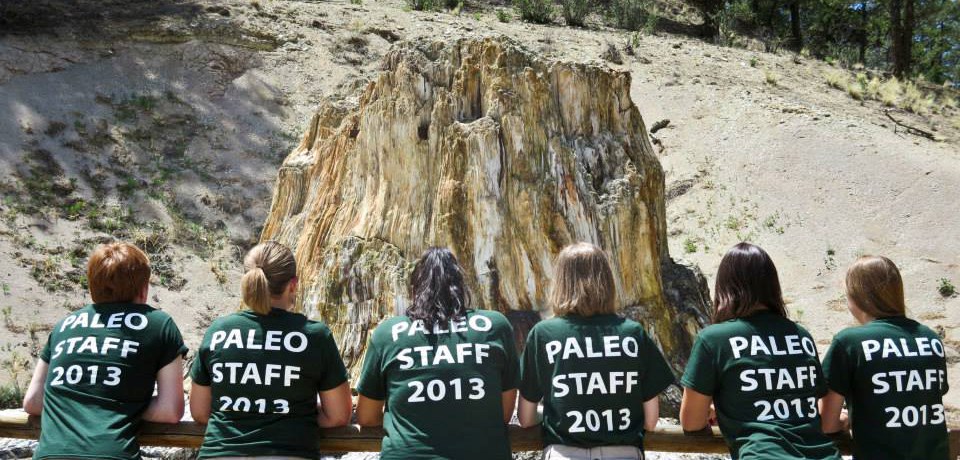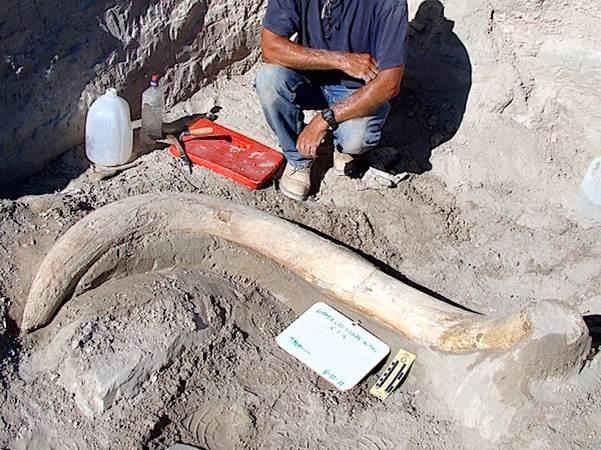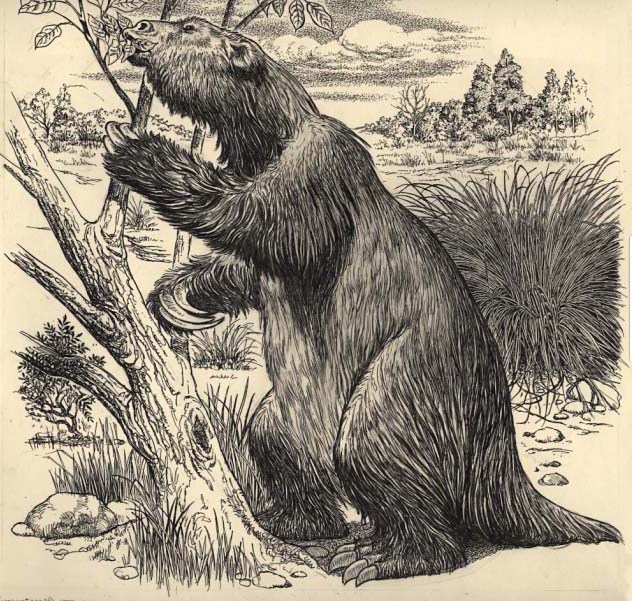History of Paleontology in the National Park Service—Santucci, V. L. (page 8 of 9)

NPS photo.
Introduction
As the NPS paleontology program continued to grow, more than 200 paleontology interns were recruited to support fossil-related projects in parks. Additionally, the Paleontological Resource Preservation Act was signed into law in March 2009, the National Park Service Junior Paleontologist Program was created, and National Fossil Day was established as part of Earth Science Week.
Paleontological Resources Preservation Act of 2009 Signed into Law
On March 30, 2009, President Barack Obama signed the Paleontological Resource Preservation Act into law. Approximately 30 years after the Archaeological Resources Protection Act was signed into law on October 31, 1979, an equivalent federal authority was promulgated for paleontological resources. The Paleontological Resource Preservation Act is authorized for five federal land managing agencies including the: Bureau of Land Management, Bureau of Reclamation, Fish and Wildlife Service, National Park Service, and U.S. Forest Service. The law includes mandates pertaining to the:
inventory, monitoring, and the scientific and educational use of paleontological resources . . . (Public Law 111-011).
The legislation also contains language pertaining to paleontological resource permits, museum collections, criminal and civil penalties, and confidentiality of sensitive resource information.
Paleontological Resource Monitoring Strategy Developed and Piloted
The National Park Service pioneered some of the first discussions and strategies devoted to the monitoring of in situ paleontological resources (Santucci and Koch 2003; Santucci et al. 2009). In 2009, Glen Canyon National Recreation Area, Arizona and Utah, was selected as the prototype paleontological resource monitoring park for the National Park Service. Glen Canyon National Recreation Area was selected based on the continuous fluctuations of water levels on Lake Powell, which intermittently submerged or exposed the abundant fossils which occur along the lake shoreline. Low lake water levels, related to droughts in the western United States, exposed many new fossil track sites which were submerged for many decades. The methods employed for paleontological resource monitoring at Glen Canyon National Recreation Area captured baseline data to measure changes in the stability and condition of the fossils over time (Kirkland et al. 2010). The monitoring strategy evaluates both natural and human factors contributing to the condition of in situ paleontological resources. Paleontological resource monitoring continues at Glen Canyon National Recreation Area and has been initiated in several other National Park Service areas.
Establishment of National Fossil Day as a Nationwide Partnership

NPS image.
The Paleontological Resource Preservation Act states: “The Secretary shall establish a program to increase public awareness about the significance of paleontological resources.” In response to this provision in the law, the National Park Service and American Geosciences Institute proposed a partnership called National Fossil Day to promote the scientific and educational values of fossils. The first National Fossil Day was hosted on October 13, 2010, during Earth Science Week, with a public event celebrating fossils on the National Mall in Washington, D.C. More than 500 children participated in the National Park Service Junior Paleontologist Program, a fossil-themed educational activity which premiered in June 2010 to promote interest in science and stewardship among children. By 2020, the National Fossil Day partnership had expanded to include more than 380 partners across the United States and in every state; providing fossil-focused educational activities for children, families, and others at the local level. Additionally, during this time period, the National Park Service developed the Junior Paleontologist Activity Booklet to promote interest in science and stewardship among children.
Establishment of Tule Springs Fossil Beds National Monument

On December 19, 2014, Tule Springs Fossil Beds National Monument, Nevada, was established as a unit of the National Park Service. According to the authorizing legislation the monument was established:
In order to conserve, protect, interpret, and enhance for the benefit of present and future generations the unique and nationally important paleontological, scientific, educational, and recreational resources and values . . . (Public Law 113-291).
The monument consists of lands transferred to the National Park Service from the Bureau of Land Management. Pleistocene sedimentary deposits in the upper Las Vegas Wash have yielded abundant ice age megafauna fossils (mammoths, camels, sloths, etc.) and have been the focus of field collecting and research (Springer et al. 2017). Also see A really ‘Big Dig’ at Tule Spring Fossil Beds (1916–1966).
Establishment of Waco Mammoth National Monument
On July 10, 2015, Waco Mammoth National Monument, Texas, was established as a unit of the National Park Service by President Barack Obama. According to the proclamation, the monument was created as:
a partnership between the City of Waco, Baylor University, and the Waco Mammoth Foundation, Inc., . . . [to] maintain the Waco Mammoth Site and expand the partnership to include the National Park Service [and] to preserve and protect the scientific objects at the Waco Mammoth Site. (Barack Obama, Proclamation 9299).
The history of the fossil locality dates back to the discovery of a fossil bone during the spring of 1978 by Paul Barron and Eddie Bufkin. The two men collected the bone and took it to Baylor University’s Strecker Museum (now Mayborn Museum) where it was identified as a femur from a Pleistocene Columbian mammoth (Mammuthus columbi). To date, the site has yielded the remains of 25 mammoths, which represent the largest known concentration from a single herd dying during the same event, along with the remains of camel, dwarf antelope, American alligator, giant tortoise, and the tooth of a juvenile saber-toothed cat (Bongino 2007; Nordt et al. 2015; Weist et al. 2016).
First National Park Service PaleoBlitz hosted
As part of the National Park Service Centennial Celebration, more than 100 Bioblitz events were hosted in parks throughout the country. On May 20–21, 2016, the first official National Park Service PaleoBlitz was hosted at Chickasaw National Recreation Area, Oklahoma. The PaleoBlitz consisted of two components including field paleontological resource inventories conducted by a team of paleontologists, and a fossil education and outreach event for the public.
Establishment of Katahdin Woods and Waters National Monument Recognizes Fossils
On August 24, 2016, Katahdin Woods and Waters National Monument, Maine, was established as a unit of the National Park Service by President Barack Obama. According to the proclamation the significance of the monument includes:
bedrock spanning over 150 million years of the Paleozoic era, revealing a remarkably complete exposure of Paleozoic rock strata with well-preserved fossils. (Barack Obama, Proclamation 9476).
Fossils were first reported from the area now within Katahdin Woods and Waters National Monument during the American Civil War (Hitchcock 1861). Extensive fossil collections have been obtained from the monument including at least four holotype fossil specimens (Clarke 1907; Elias 1982).
Fossil Track Surprises at White Sands National Monument

NPS image.
The gypsum sands that give White Sands its name are a trace of the vast Lake Otero, which dried up following the most recent Ice Age. Before that, during the late Pleistocene, the lake was the centerpiece of a much different world, inhabited by ground sloths, mammoths, camels, dire wolves, extinct big cats, and other large mammals that have also vanished. Their tracks are exposed by the shifting sands, but once exposed are fragile and soon lost to erosion. Study of the tracks began in earnest in the early 21st century, aided by techniques such as photogrammetry, which allows scientists to capture the tracks as 3-D digital documents. During study, it became apparent that some of the tracks were actually made by people, providing rare evidence of the interaction of early North Americans with extinct Pleistocene fauna. Some of the trackways appear to show humans hunting ground sloths (Bustos et al. 2018).
On December 20, 2019, in part because of these discoveries, White Sands National Monument became White Sands National Park.
Paleontology and the Second Century for the National Park Service
The Paleontological Resources Preservation Act (PRPA) regulatory process will have a profound influence over the direction of paleontology for the National Park Service and other bureaus in the Department of Interior. The PRPA mandates for inventorying, monitoring, educational outreach, permitting, curation and resource protection, all of which will enhance the stewardship of fossils on federal lands. New partnerships are being formed between the primary paleontology-focused professional organizations and the National Park Service to create opportunities to promote public engagement to support the management of fossils in parks. It is anticipated that dozens of paleontology students will be recruited annually to help parks with projects and outreach involving park fossils.
In addition to preserving fossils in the parks, the preservation of historic and scientific archives and data associated with National Park Service fossils is critical. An organizational framework for the National Park Service Paleontology Archives & Library has been developed and will serve as an important repository for both digital and hardcopy documents, maps, photos and other information pertaining to National Park Service fossils. This will be an extremely important source for paleontology information for future National Park Service managers, paleontologists, researchers and others.

NPS image.
The National Park Service will continue to coordinate the National Fossil Day partnership and outreach activities to promote the scientific and educational values of fossils throughout the United States. During 2017, the number of children who have taken the Junior Paleontologist Program pledge will reach 100,000.
The next chapters for the history of paleontology in the National Park Service will be written in the upcoming years, decades and beyond. As the Junior Paleontologists grow up, the paleontology interns complete their education, and the public and professional support for fossils in parks expands, there will be many new stories to add to this rich history of National Park Service paleontology. This journey has only begun and the future will most certainly help us to better understand the past.
Related Links
-
Glen Canyon National Recreation Area (GLCA), Arizona and Utah—[GLCA Geodiversity Atlas] [GLCA Park Home] [GLCA npshistory.com]
-
Katahdin Woods and Waters National Monument (KAWW), Maine—[KAWW Geodiversity Atlas] [KAWW Park Home] [KAWW npshistory.com]
-
Tule Springs National Monument (TUSK), Nevada—[TUSK Geodiversity Atlas] [TUSK Park Home] [TUSK npshistory.com]
-
Waco Mammoth National Monument (WACO), Texas—[WACO Geodiversity Atlas] [WACO Park Home] [WACO npshistory.com]
-
White Sands National Monument (WHSA), New Mexico—[WHSA Geodiversity Atlas] [WHSA Park Home] [WHSA npshistory.com]
Last updated: April 27, 2023
